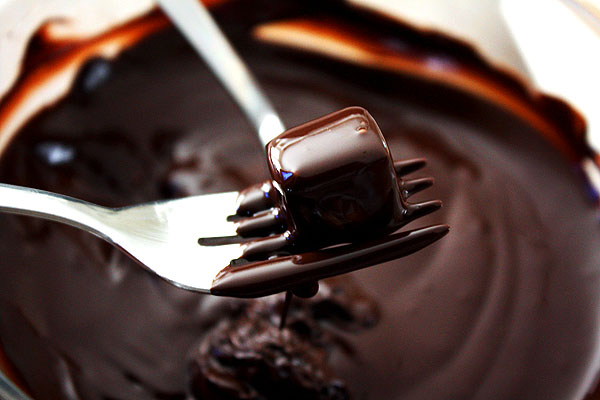How to...
 Today I'm searching the net on How TO....effectively dip things in chocolate. Now I've tried this all before to no avail...all on my own with no help.. Well it's time to consult the experts...lol. Here's a article I found below...
Today I'm searching the net on How TO....effectively dip things in chocolate. Now I've tried this all before to no avail...all on my own with no help.. Well it's time to consult the experts...lol. Here's a article I found below...Chocolate Dipping Tips
I am by no means a professional, but am happy to
share some of my chocolate dipping tips with you. If you have not yet read my
tab working with chocolate. I highly recommend that you do. This page will explain a
little about tempering and will help you choose a good chocolate to dip with, as
well as help you decide between chocolate and candy melts.
If you are ready to dip... read on!
Chocolate Dipping
Tools
You don't need a lot of fancy tools for chocolate dipping at home. You can use a simple fork or spoon to rest cookies or other treats on while you dip them into chocolate, but since the dipping sets are so cheap, I do recommend getting a set if you are planning to dip more than once. The "fork" is particularly useful for cookies, and the "spoon" is best for truffles and cake bites. The dipping spoon in particular, allows excess chocolate to drip off through the hole in the middle, so your finished product will not be resting in a big pool of chocolate like it will if you use a regular spoon. Some stores also sell plastic sets which are only a few dollars but I prefer the metal sets for repeated use.
Dipping... What do I actually
DO?
1. Prepare your item to be dipped.
If you want to practice or experiment, Oreo
cookies are a great starting point. Have your item of choice out, at room
temperature (unless otherwise stated in the recipe), and completely dry.
Dampness can seize your chocolate, so when dipping fruits and other damp items,
it is best to let them drain or "dry out" for 15 minutes or so on a countertop.
Be sure to pat them dry before beginning.
2. Choose an appropriate container.
If you are dipping something long like pretzel
rods, it may be a good idea to melt your chocolate in a tall skinny glass so
your chocolate will be very "high" on your rod. If you are using only a small
amount of chocolate, or dipping only a few treats, it is a good idea to melt
your chocolate in a custard bowl or shallow cup. This will make your chocolate
higher in the container so you can completely submerge your treats. If you are
using large amounts of chocolate it usually does not matter what container you
use; just make sure it is microwave safe!
3. Melt your chocolate.
Break or cut your chocolate into small chunks.
Microwave at 50% power in increments of 30 seconds, stirring after each
interval. After 1 min 30 seconds, melt in intervals of 10-15 seconds only. Do
not let the chocolate get too hot. If your mixture is nearly all smooth, don't
microwave again, but stir for a few minutes, allowing the hot chocolate to melt
the remaining chocolate lumps.
You want your chocolate to be "of dipping
consistency". This means, very thin. A thin chocolate will coat your dipping
item smoothly and evenly and will drip off nicely. If your chocolate is
completely melted and still not thin, you may need to add a bit of shortening or
vegetable oil to thin it out. (This is often the case when using chocolate
chips because they contain wax and other thickeners.)
4. Dip your item.
Be sure that your chocolate is not TOO hot (it
will run right off your treat and won't leave a very thick coating) and not too
cool (it will "gloop" on your dipped item and will not run off nicely and
evenly.) As your practice, you will come to know when your chocolate is at the
best temperature for dipping.
Place item to be dipped on chocolate dipping fork
or spoon (or use a regular fork or spoon) and dip straight down into your
chocolate mixture. If the chocolate is not deep enough for the item to be
completely submersed, either dip your item half-way (cookies dipped half in
chocolate look great), or tilt your container towards you about 45 degrees to
make a little "pillow" of chocolate in front which is deep enough to cover your
treat. If you'd like you can roll your treat around in the chocolate, or turn it
over several times to get it completely coated. Pull the item back out with
chocolate dipping fork or spoon.
TAP the fork or spoon gently on the side of
your container. This will pull excess chocolate back into the container and
will leave less of "puddle" when you set your treat down to cool. It will also
help you get a smooth coat on your treat.
5. Place your dipped treat onto a parchment
lined tray.
The parchment will keep the chocolate from
sticking. A Silpat is another alternative. When all treats have been dipped,
move the tray to the refrigerator if desired to help them cool quickly. You can
also use the freezer but the quick cooling of the chocolate can sometimes cause
cracks in your chocolate so I do not recommend this.
6. Remove from refrigerator when set and
package up or consume.
Treats can be stored in the refrigerator, but
chocolate can bloom or turn grainy after a few days in the refrigerator so keep
this in mind. (This can also happen out of the refrigerator, but I've found it
much more likely in the fridge as the cool temperature exacerbates the
separation).

Comments
Post a Comment